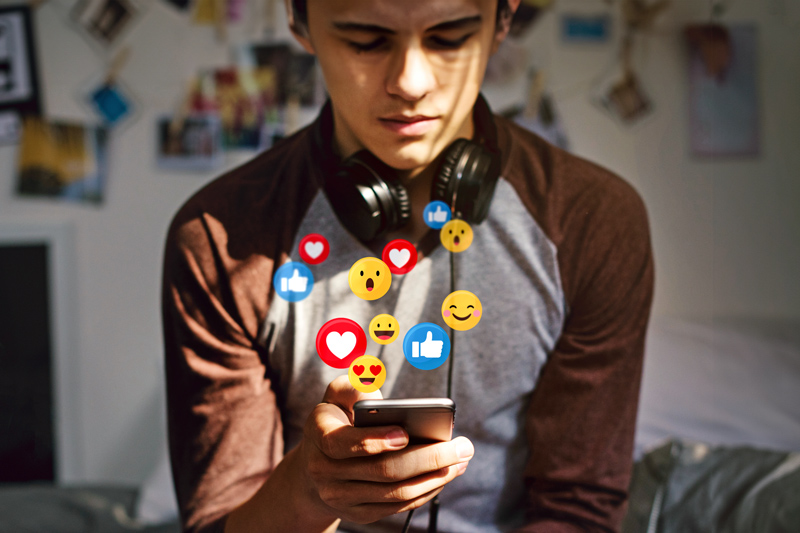From setting morning alarms to random late-night scrolling, screens have become our irreplaceable companions in daily life. For work, education, or entertainment, devices take over our routines. Recent Average Screen Time statistics by Exploding Topics show that the average person spends approximately 6 hours and 40 minutes daily glued to the screen.

However, this prolonged screen time comes at a cost, affecting the individual’s sleep patterns and mental health. A report by the National Center for Health Statistics shows that 50% of teenagers aged 13-17 spend more than 4 hours on the screen connected to the internet, with a significant number of these adolescents experiencing anxiety and depression.
So, how can we tackle these challenges by taking back control over technology and using it mindfully? The good news is that with the help of many strategies, we can still use technology without being addicted to it.
Understanding Digital Well-Being
Digital well-being is maintaining healthy connections between people and a device, thus using it to benefit you rather than consume you. This practice demands mindfulness of asking yourself when, why, and how to engage with a screen in a way that prevents you from distractions, mental stress, and burnout. Being conscious of how you use the screen can make a big difference, resulting in technology helping you rather than taking over.
The Unseen Dangers of Excessive Digital Technology Use
Overusing regular digital devices isn’t a minor inconvenience but a real trouble and can adversely affect an individual’s health.
We, as adults, show kids how to live. But many of us are always on our phones. We wake up and immediately check our phones.
Kids see this and do the same. They spend too much time on screens, which can cause problems:
- Sadness and anxiety.
- Trouble talking to people face-to-face.
- Health issues, like being overweight or not sleeping well.
- Trouble paying attention in school.
Research published in the National Library of Medicine shows the impact of long periods in front of screens, resulting in disrupted sleep cycles and reduced energy levels of students, making them less productive and less academic. The screens that wipe out the blue light stop the body from producing melatonin and make it difficult to get to the path of restful sleep. People in modern society experience more stress and anxiety signs because there is a kind of necessity to stay online and respond in real-time. The social pressure with which people stay online can have adverse effects on their mental health. Thus, people may develop compulsive behaviors as a result.
Strategies for Digital Well-Being
Everything in life requires balance, and so does technology use. Ditching screen time isn’t easy, so you must balance on and off-screen time by practicing the following strategies.
1. Use of Digital Well-Being Apps. Have you ever thought about how much time you spend on your phone? Many apps like Apple’s ‘Screen Time’ and ‘Digital Well Being help you track daily device use and provide tools such as app usage and time off limits. Digital distractions aside, other productivity apps like ‘Forest,’ ‘Detox,’ and ‘OffTime’ can function as distractions by rewarding you for staying off-screen. There is evidence that handling screen time using such app-based interventions reduces screen time and encourages mindful use of technology. A study published in the Journal of Medical Internet Research suggests that these apps can effectively minimize screen time and promote mindful technology engagement.
2. Setting Tech-Free Zones and Times. Introduce areas throughout your house that forbid screens, including the dining space and your sleeping area. Live dinner conversations have become more prevalent, and improved bedtime rest results from technological restrictions. A nighttime screen ban beginning one hour before bedtime assists people in stopping their continuous evening screen usage.
3. Swap Screen Time for Offline Activities. Encouraging hobbies that avoid screen-related activities, like physical reading alongside sports and creative activities, leads to a noticeable decrease in total screen hours used. Promoting wellness programs by educational institutions and work environments provides scheduled digital device rest periods, which foster participation in traditional real-life activities.
4. Group-Based Digital Detox Programs. Interventions provided through groups are more straightforward to introduce than those done personally, and social support provided through them will help individuals reduce their screen time. Programs like ‘NUGU’ have been used effectively to help students manage digital distractions. These programs use a digital usage environment to allow participants to set their digital usage goals through collaboration and make each other accountable for achieving them. Motivation and the probability of reducing digital consumption are built with having a sense of community.
5. Digital Detox Practices. Digital detox is a period of agreed-upon abstinence from digital devices. This allows one to reconnect with the physical world, reduce the amount of stress one is under, and enhance sleep quality. The National Day of Unplugging is when people are prompted to take a break from technology and spend time with things of the real world. One report by Cyberpsychology, Behavior, and Social Networking shows that a multigroup analysis was conducted among 500 young adults between 18 and 35 years of age to compare digital detox app users and non-users. Results showed that a high number of adults used digital detox apps. Thus, a regular digital detox can improve mental clarity and well-being.
Challenges in Implementing Digital Well-Being Strategies
Even as digital well-being tools and strategies are becoming available, there is a lack of effectiveness in implementing them. It is a regular occurrence that many individuals cannot maintain a self-imposed limit and tend to revert to old habits. Similarly, technology can also be used to counter and aid in the social use of the tool; peer pressure and workplace demands might not be so easy to disrupt, and utilizing less screen time. Better effectiveness may require the personalization of interventions with respect to individual needs and lifestyles.
Looking Ahead: The Future of Digital Well-Being
Future research is needed to determine the most effective digital well-being interventions. Awareness programs and encouraging responsible technology use can help educational institutions, as well as workplaces, play a role in promoting digital wellness. New Digital well-being technologies can be developed further to be more personalized and to help users adopt healthier digital habits according to their behaviors via artificial intelligence.
Conclusion
A healthy and happy life is balanced well by using technology. Since technology is here to stay, we cannot avoid it; rather, we can look for ways to use it. Maintaining a balance between online and offline life is essential. By incorporating small but effective changes—like using screen time apps, setting tech-free zones, and taking regular digital detoxes—we can reclaim our time and use technology as a tool for empowerment, not exhaustion.
Temitope Fabayo, BA, MBA, is President of DMC HomeCare.
References
Duarte, F. (2022, September 21). Alarming Average Screen Time Statistics (2024). Exploding Topics. https://explodingtopics.com/blog/screen-time-stats?utm_source
Nakshine, V. S., Thute, P., Khatib, M. N., & Sarkar, B. (2022). Increased Screen Time as a Cause of Declining Physical, Psychological Health, and Sleep Patterns: A Literary Review. Cureus, 14(10). https://doi.org/10.7759/cureus.30051
Rahmillah, F. I., Tariq, A., King, M., & Oviedo-Trespalacios, O. (2023). Evaluating the Effectiveness of Apps Designed to Reduce Mobile Phone Use and Prevent Maladaptive Mobile Phone Use: Multimethod Study. Journal of Medical Internet Research, 25, e42541. https://doi.org/10.2196/42541
Zablotsky, B. (2024). Daily Screen Time Among Teenagers: United States, July 2021 – December 2023. Daily Screen Time among Teenagers: United States, July 2021–December 2023, 513(513). https://doi.org/10.15620/cdc/168509




